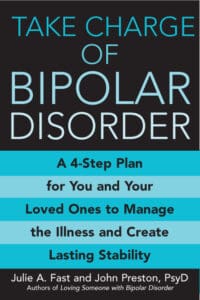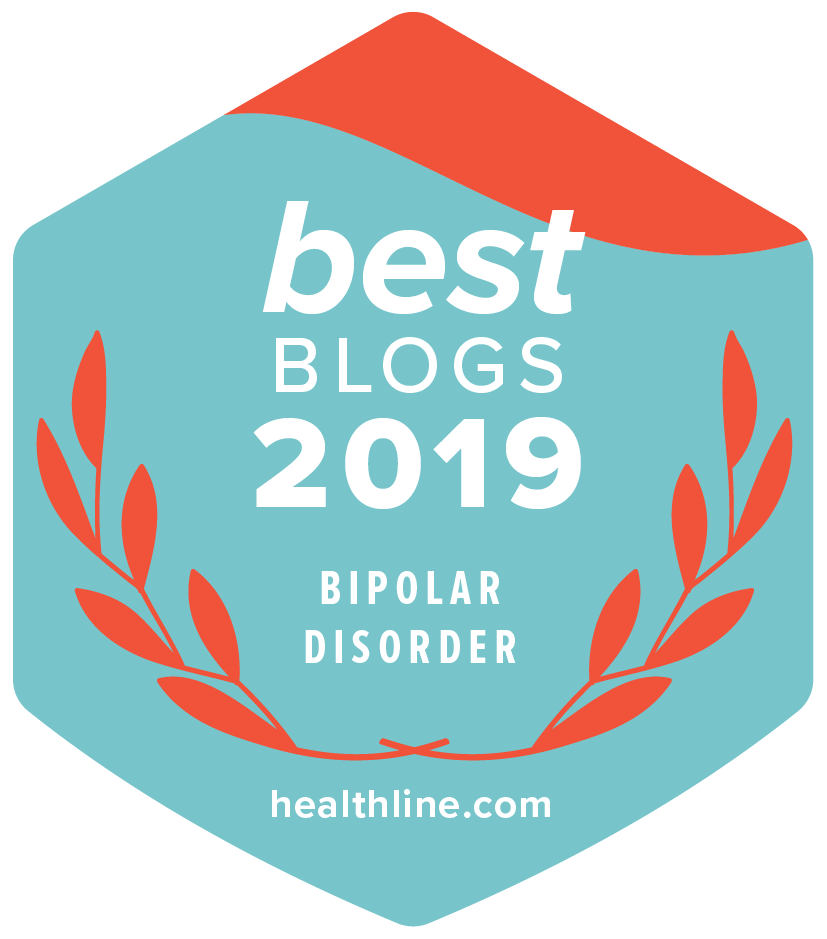Bipolar disorder is an illness that appears very, very confusing when you have just been diagnosed or if someone you love has a possible or official diagnosis.
Here is some great news. The illness is NOT difficult to understand once you know the basics.
The following is an excerpt from my book Take Charge of Bipolar Disorder: A 4-Step Plan for You and Your Loved Ones to Manage the Illness and Create Lasting Stability.
I’ve written books on the topic of bipolar disorder for over ten years since my partner of 10 years was diagnosed in 1994 and I was diagnosed in 1995.
Take Charge of Bipolar Disorder is the book I recommend for learning the basics of the illness, especially if you have just been diagnosed. It’s great for family members, partners and health care professionals as well.
The following is a technical explanation of bipolar disorder from the introduction to Take Charge of Bipolar Disorder.
An Explanation of Bipolar Disorder
Bipolar disorder is a mood disorder. Mood disorders include bipolar disorder and depression. Although symptoms can overlap with those of other mental illnesses, mood disorders are different, for example from schizophrenia, which is a psychotic disorder and borderline personality disorder, which is a personality disorder. If you give people an explanation of bipolar disorder, you can tell them that it’s a mood disorder that affects the chemicals in your brain and causes change in moods that are often not normal responses to outside events. More technically, bipolar disorder is a genetically transmitted medical illness that affects brain chemistry. It results in abnormal regulation of never cells that are responsible for emotional regulation. This abnormality in brain chemistry leads to difficulties in controlling strong emotions and periodically causes intense episodes of either mania or depression as well as a wide variety of other symptoms including anxiety, ADHD symptoms, psychosis and sleep disturbances.
**
And now for a basic explanation of the symptoms of the illness:
Bipolar I (one) and Bipolar II (two).
There are two main types of bipolar disorder: Bipolar disorder I (one) and bipolar disorder II (two). The main difference between the two is the type of mania a person experiences.
It is very important to note that mania must be present at some point before a person can be diagnosed with bipolar disorder. There are not exceptions.
Bipolar I has full blown mania. Bipolar II has hypomania.
If you have a diagnosis, you need to know what type of the illness you have as the medications used are quite different.
What is Rapid Cycling?
Though the symptoms of the illness (described below) stay the same, the frequency and duration of mood swings differs greatly in people with the illness. A person has rapid cycling if they have three or more mood swings a year. Some people with the illness, like myself can have dozens or more mood swings a day. Research shows that 20% of people with the illness has rapid cycling. In my experience, I feel the numbers are much higher.
There are two main mood swings in bipolar disorder: depression and mania. Here are more excerpts from Take Charge of Bipolar Disorder:
What is Bipolar Depression? ‘
Depression is much more than sadness and unhappiness. .. Most people with bipolar depression have dozens of symptoms of depression. Here are just a few symptoms of bipolar disorder. Check the ones that you (or your loved one) experiences:
- Sadness, unhappiness, feelings of despair and hopelessness.
- Irritability, frustration, low tolerance and anger.
- Low self esteem, feeling worthless or inadequate, loss of self confidence.
- Negative, pessimistic thinking. A bleak view of yourself, current life circumstances, and the future.
- Suicidal thoughts.
- Poor memory and concentration.
- Neediness.
- Anxiety. (90% of people with bipolar depression have anxiety.)
- Feeling easily overwhelmed.
- Sleep changes from either sleeping too much or agitated sleep.
- Being overly emotional, crying easily or getting angry easily.
- Brain racing and looping, one thought or a group of thoughts that keep going through your mind over and over again.
(There is a more comprehensive list of bipolar depression symptoms in Take Charge of Bipolar Disorder.)
What is Mania?
Full blown mania and hypomania share most of the symptoms below- but in differing degrees. One other difference is that those with full blown mania have a high incidence of psychosis when there is a strong manic episode.
Mania is a chemically elevated mood that can be either euphoric or dysphoric (also called expansive mania, agitated mania or mixed mania). Full blown mania often leads to severe social impairment and occupational dysfunctioning and usually requires hostpitalization.
Hypomania is also described as an abnormal or persistently elevated, expansive or irritable mood. (This is the dysphoric mania.) Hypomanic mania if often of a short duration, but can last for months. The difference is that although mania and hypomania have an identical list of characteristic symptoms (with psychosis being the exception), the disturbance caused by hypomania is not usually severe enough to result in marked impairment in social or occupational functioning or to require hospitalization. Though there are exceptions, especially with euphoric mania.
Manic and hypomanic episodes often begin suddenly, with a rapid escalations of symptoms over a few days.
The following lists a few symptoms of bipolar mania. Take Charge has a very comprehensive list:
Euphoric mania:
- Feeling great no matter what happens.
- A profound feeling of physical well being.
- Increased self esteem or grandiosity. ( This can be with psychotic mania as well.)
- Decreased need for sleep without being tired the next days. For some this is sleeping 4-5 hours a night, for others it’s not sleeping at all.
- Talkativeness and rapid speech. Pressured speech where you can’t let others talk.
Dysphoric (agitated) Mania:
- Hyperactivity, restlessness or agitation.
- Both euphoric and dysphoric mania:
- Talkativeness and rapid speech. Pressured speech where you can’t let others talk.
- Increased use of alcohol and drugs. Eating usually decreases.
- Increased sexual desire.
- Poor judgment and engaging in high-risk behaviors: reckless driving, excessive spending sprees, gambling, giving away large sums of money.
- Inability to see that you’re ill.
**
Mania can be ignited by the use of antidepressants, stimulants (ADHD medications) light therapy and drugs such as steroids (cortisol, etc.) Anti depressants and stimulants can be used along with a mood stabilizer, but they have to be carefully monitored for mania symptoms.
Other Symptoms of Bipolar Disorder
The final symptoms of bipolar disorder include psychosis, anxiety and irritated, anger aggression and violent behavior. These symptoms can lead to paranoia, OCD and cognitive problems such as those found in ADHD. Take Charge of Bipolar Disorder has an extensive list of these symptoms. Bipolar disorder is not just mania and depression, so a knowledge of the above symptoms is essential.
The Good News
When symptoms of bipolar disorder appear to be random and chaotic, with no apparent rhyme or reason, it’s easy to feel overwhelmed. It’s important that you understand all of the possible symptoms of bipolar disorder and come to see them as common and even predictable manifestations of bipolar disorder. Not only can this take the mystery out of the experience of bipolar disorder episodes, but it can also help you communicate clearly to your health care professional when particular symptoms emerge. Finally, knowing the nature of these symptoms is also a necessary starting point for developing a rational treatment plan.
(A side note. If you care about someone with the illness and they are in denial, can’t see they are ill or are hospitalized at this time, learning all you can about the illness will give you the information needed to recognize bipolar symptoms so that you can help a loved one get into treatment.)
Knowledge Matters
Learning about bipolar disorder puts you in control and helps you become a participant in your own healing, instead of just a spectator to the professionals who manage your medications. Knowledge really is power. The more you know, the more likely you are to remind yourself that this is just an illness that needs management, instead of feeling that it’s some personal failing on your part because your emotions go all over the place.
*end excerpt*
Take Charge of Bipolar Disorder is such a wonderful book for learning the basics of the illness and how it can be successfully treated and managed.
If you’re overwhelmed, Take Charge of Bipolar Disorder will answer the basic questions about bipolar disorder symptoms, the medications used to treat the illness and how to successful manage this illness in all areas of life.
Take Charge of Bipolar Disorder is available on amazon.com (where is has been one of the top books on bipolar disorder for over five years. Here is a link to the book on amazon.com:
Take Charge of Bipolar Disorder on amazon.com
It is also available in my treatment system for bipolar disorder from the following link. If you scroll down to the bottom of the page, you will see the books in the package.
Julie’s treatment system package
We can all get better and family members, partners, friends and health care professionals can learn to help.
Julie






